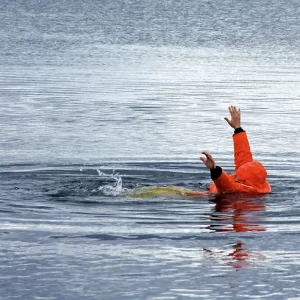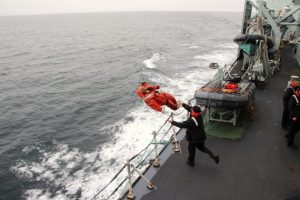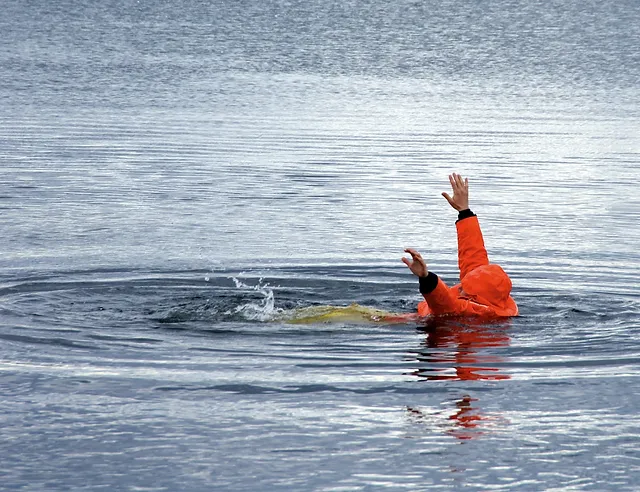A man overboard (MOB) situation is one of the most critical emergencies at sea, requiring immediate action to maximize the chances of survival. Whether it involves a crew member or a passenger, knowing the proper procedures, signals, and rescue protocols is essential for ensuring safety on ships.

Here are the answers to 5 key questions about Man Overboard at sea, followed by an explanation of Man Overboard Drills on ships:
1. What Happens When a Person Falls Overboard from a Ship?
When a man overboard incident occurs, the immediate priority is to:
- Alert the crew – The person who sees the incident must shout “Man Overboard!” and notify the bridge.
- Mark the location – Throw a lifebuoy with a light and smoke signal to help locate the person in the water.
- Activate MOB alarms and signals – The ship’s emergency procedures begin immediately.
- Initiate search and rescue (SAR) operations – The vessel executes maneuvers to recover the individual.
- Inform authorities – The ship’s master notifies coastal rescue coordination centers (if needed).
Swift response and proper communication can significantly increase the chances of survival.
2. What Are the Standard Man Overboard Procedures?
The MOB procedure includes several key steps:
Immediate Actions
- Sound the MOB alarm and announce it over the public address system.
- Stop or slow down the ship while maintaining sight of the person.
- Deploy life-saving equipment, such as lifebuoys and rescue boats.
Ship Maneuvers for Rescue
The following ship maneuvers are commonly used to retrieve a person from the water:
- Williamson Turn – A controlled turn that brings the ship back to its original position.
- Scharnow Turn – Used when the ship has traveled far beyond the person’s location.
- Anderson Turn – A quick maneuver when the person is spotted immediately.
These procedures are part of mandatory safety drills conducted onboard.
3. What Is the Man Overboard Signal?
The MOB signal is an internationally recognized alert that signifies a person has fallen overboard. The standard procedures include:
- Sounding three long blasts on the ship’s whistle and general alarm.
- Announcing “Man Overboard” on the PA system.
- Activating emergency lights and signals.
- Broadcasting a distress call via VHF radio using the MOB distress message:
- “Mayday, Mayday, Mayday – Man Overboard!”
These signals ensure that all crew members and nearby vessels are aware of the emergency.
4. What Does “Man Overboard” Mean in Maritime Terms?
The term “man overboard” (MOB) is used to describe any incident where a person falls into the sea from a vessel. It applies to:
- Crew members performing duties on deck.
- Passengers on cruise ships or ferries.
- Fishermen or offshore workers on oil rigs and platforms.
A MOB situation is life-threatening, as individuals face risks of hypothermia, drowning, or being lost at sea.
5. What Is the Purpose of a Lifebuoy in a Man Overboard Situation?
A lifebuoy (or life ring) is a floating safety device used to:
- Mark the person’s location in the water.
- Provide immediate buoyancy to keep them afloat.
- Serve as a visible reference for rescue teams.
Modern lifebuoys often include:
- Self-activating lights for nighttime visibility.
- Smoke signals to improve tracking.
- Rescue lines for pulling the person to safety.
Proper use of lifebuoys is part of every ship’s emergency drills.

Man Overboard (MOB) Drills on Ships : A Guide to Emergency Response
– Regulatory Framework
Man Overboard (MOB) drills are a fundamental aspect of maritime safety training, designed to equip seafarers with the skills and knowledge required to respond effectively to emergencies involving individuals falling overboard. These drills are mandatory under international maritime conventions, including:
- SOLAS Convention (Safety of Life at Sea) – Specifies lifesaving equipment and emergency response protocols.
- ISM Code (International Safety Management Code) – Ensures ships implement structured Safety Management Systems (SMS) for emergency preparedness.
- STCW Convention and Code(Standards of Training, Certification, and Watchkeeping for Seafarers) – Establishes competency standards for crew members in emergency response.
- MARPOL Convention(Marine Pollution Prevention Convention) – Guides environmental considerations during MOB recoveries.
By regularly conducting MOB drills, ships ensure crew readiness, compliance with IMO regulations, and the highest standards of maritime safety.
– Objectives of a Man Overboard Drill
-
Ensuring a Prompt and Coordinated Response
- MOB drills train crew members to immediately recognize and react to a man overboard situation.
- Actions include sounding the alarm, alerting the bridge, and initiating search and rescue (SAR) operations, as per SOLAS and STCW requirements.
-
Practicing Effective Recovery Operations
- The crew rehearses retrieval techniques, using lifebuoys, rescue boats, and MOB recovery equipment approved under SOLAS.
- MARPOL guidelines ensure environmental protection during recovery operations, preventing oil spills or waste discharge.
-
Enhancing Coordination and Communication
- The ISM Code mandates clear communication protocols and role allocation among crew members.
- Efficient coordination between the bridge, deck, and engine room personnel ensures smooth execution of the MOB procedure.
Key Elements of an Effective MOB Drill
1. Alarm Activation and Immediate Actions
- The MOB alarm is sounded.
- The last known position of the overboard individual is marked using:
- Smoke markers
- Lifebuoys with lights
- Ship’s GPS coordinates (as per SOLAS guidelines).
- The bridge initiates an emergency broadcast to alert nearby vessels and authorities.
2. Maneuvering and Search Procedures
- The ship executes specialized maneuvers to return to the MOB position efficiently, including:
- Williamson Turn – Ensures a predictable, controlled return to the location.
- Scharnow Turn – A quicker maneuver for faster rescues.
- Anderson Turn – Used for immediate, direct retrieval.
- The search operation follows STCW-recommended patterns, using lookout teams, radar, and thermal imaging cameras (if available).
3. Retrieval and First Aid Administration
- MOB retrieval involves the use of:
- Rescue boats
- Life-saving appliances (LSA)
- Fast rescue crafts (FRCs)
- Once recovered, the individual is given immediate medical attention following SOLAS and STCW first aid protocols.
4. Environmental Protection Considerations
- MARPOL regulations mandate that MOB recovery efforts must:
- Avoid oil discharges or pollution during rescue maneuvers.
- Ensure lifeboat launches do not cause unnecessary spills or environmental damage.
Frequency, Documentation, and Evaluation
Drill Frequency and Compliance
- As per SOLAS Chapter III, MOB drills must be conducted at least once a month.
- Drills must involve all crew members to ensure operational readiness.
Mandatory Documentation (ISM Code Compliance)
Each MOB drill must be documented in detail, including:
- Date and time of the drill
- Names of participants
- Type of retrieval method used
- Crew performance observations
- Identified deficiencies and corrective actions
This documentation is critical for audits and inspections conducted by flag states, port state control (PSC), and classification societies.
Post-Drill Evaluation and Continuous Improvement
- Debriefing sessions help analyze crew performance and identify areas for improvement.
- Lessons learned are integrated into Safety Management Systems (SMS), ensuring continuous improvement in emergency response procedures.
- Flag states and Recognized Organizations (ROs) may conduct surprise drills to assess compliance.
Frequently Asked Questions (FAQs) About MOB Drills
1. Why are MOB drills mandatory on ships?
MOB drills are required under SOLAS, STCW, and the ISM Code to ensure crews are prepared to handle real-life emergencies, preventing fatalities and injuries at sea.
2. What equipment is used in a MOB drill?
Common MOB recovery equipment includes:
- Lifebuoys with self-activating lights and smoke signals
- Rescue boats and fast rescue crafts (FRCs)
- Man overboard detection systems
- Thermal imaging cameras (if available)
3. What is the most effective maneuver for MOB recovery?
- Williamson Turn – Best for night-time or poor visibility.
- Scharnow Turn – Suitable for quickly returning to an MOB position.
- Anderson Turn – Fastest method but requires precise execution.
4. What happens if a ship fails to conduct MOB drills?
- Failure to conduct drills may result in fines, penalties, or detention under Port State Control (PSC) inspections.
- Non-compliance with the ISM Code can lead to the revocation of a ship’s Safety Management Certificate (SMC).
5. How do MOB drills align with environmental regulations?
- The MARPOL Convention requires ships to avoid pollution during MOB recovery operations.
- Environmental impact is minimized through responsible use of lifeboats and emergency procedures.
Man Overboard (MOB) drills are a crucial component of maritime safety, ensuring that crews can respond swiftly and effectively to life-threatening emergencies. By adhering to SOLAS, ISM Code, STCW, and MARPOL, ships enhance emergency preparedness, reduce risks, and comply with international safety regulations.



A perfect article, thanks.